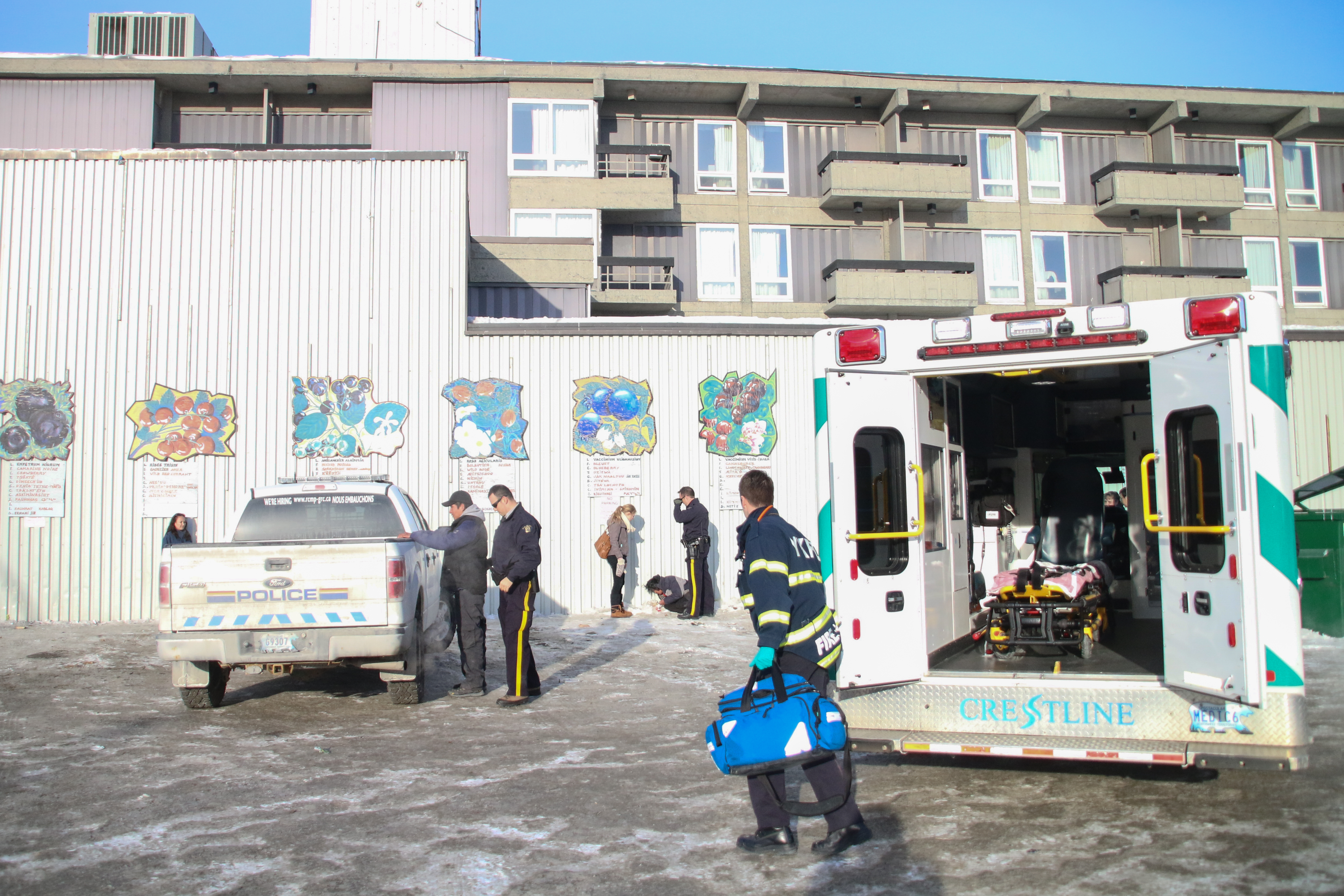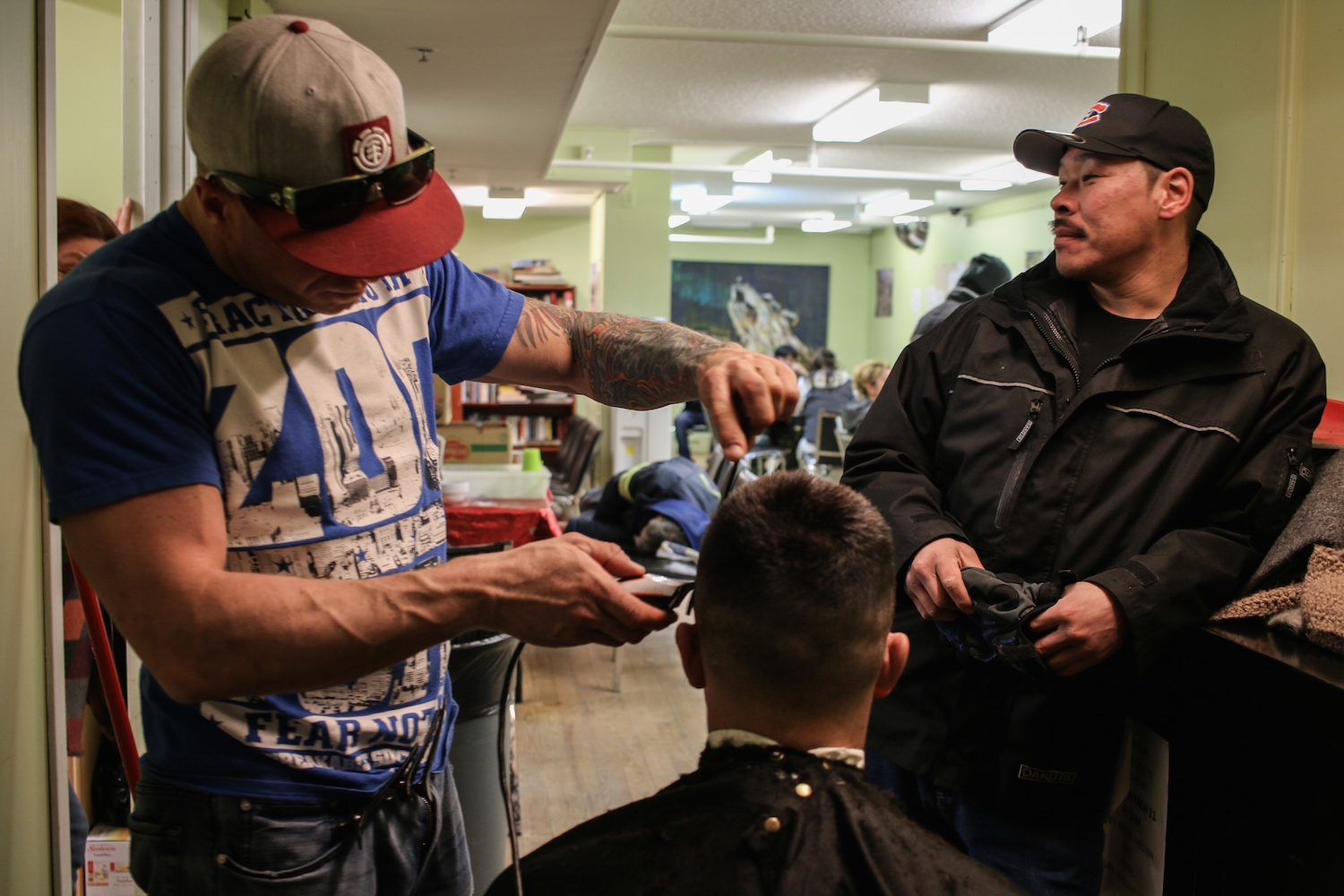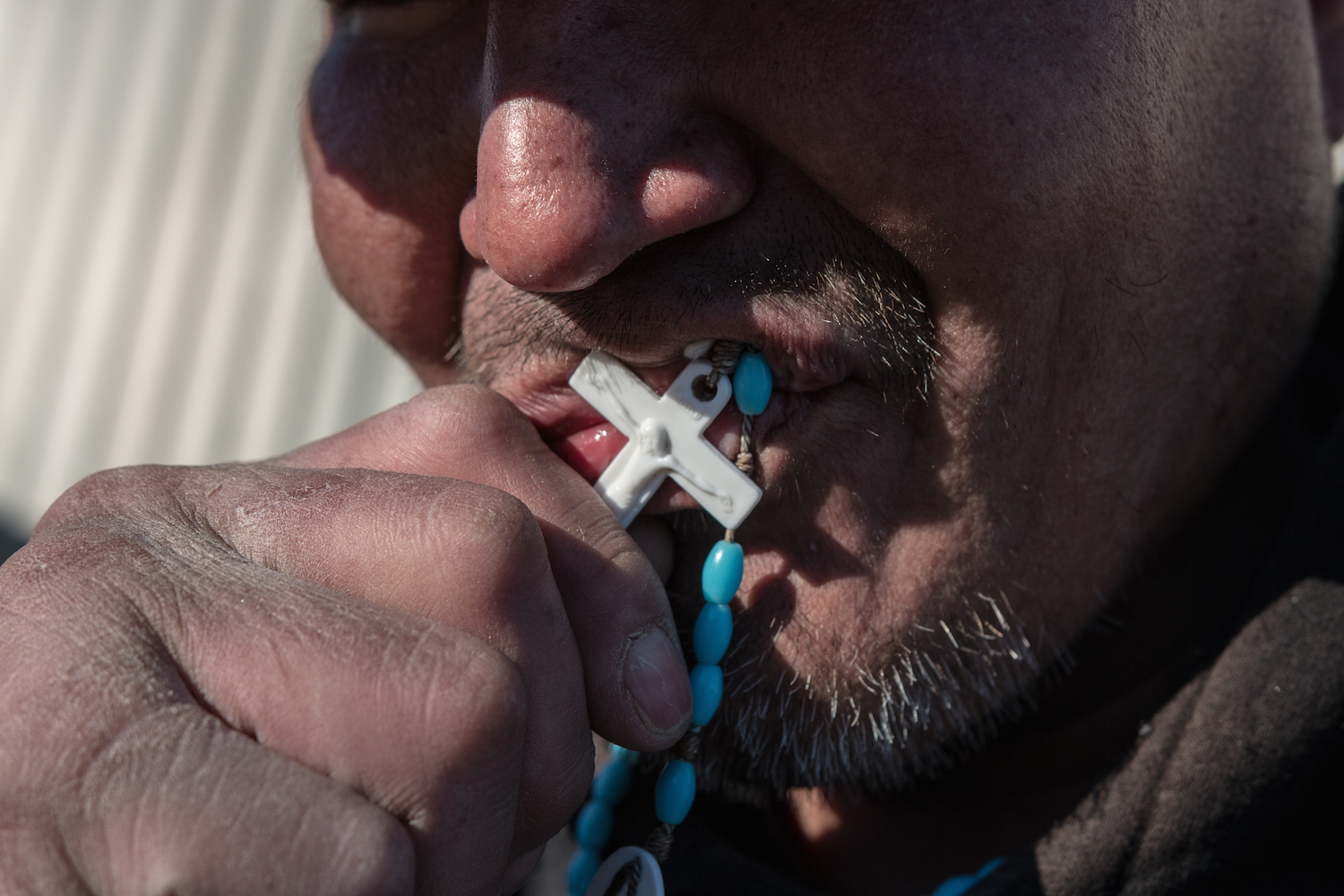Yellowknife’s Homeless Crisis
Click above photo for slideshow (24 photographs)
Yellowknife’s homeless crisis:
Government plays catch up as people try to survive
on the street in one of coldest cities in the world
Clayton Bearard takes a sip from a dark brown bottle before passing it around a circle of people across from Yellowknife’s downtown liquor store. It’s not even three o’clock in the afternoon but with a stretch of warm weather following a frigid spring blizzard, the growing huddle of street people seem happy to soak up the sun as they polish off a 26 oz. bottle of Private Stock.
Clayton, a 43-year-old originally Fort Resolution, N.T., hasn’t worked a steady job since injuring his back while working construction more than a decade ago – an accident which exacerbated a painful spinal condition that’s bothered him since he was a child. Between a monthly disability check and contracts for shovelling snow and other odd jobs, he manages to make enough to buy the booze and weed he needs to numb the physical and emotional pain that has come from living a hard life on the streets.
“I’m really a hardcore alcoholic,” Clayton confesses, his hands shaking over a can of coke the following morning.
Clayton’s burden is one which the majority of Yellowknife’s growing community of street people carry with them, often as a means to cope with the baggage of severe emotional and physical trauma. Whether it’s -30 C or 25 C – 7 a.m. or 7 p.m. – you can be assured that on any given day there will be dozens of people drinking away their pain in plain view on Yellowknife’s streets with the sound of sirens not too far off. Last spring the situation got so bad that Mayor Mark Heyck declared Yellowknife is facing a homeless crisis after coming across a woman passed out on a trail on his way to a city council meeting. “The situation with homelessness on Yellowknife streets is worse than I’ve ever seen it,” he said at the time.
While the ringing of alarms bells represents a welcome change in tone for the city, the fact is Yellowknife has long been the epicentre of a homeless crisis. Writing on the topic back in 2001, former Yellowknifer newspaper reporter and current APTN correspondent, Jorge Barrera proclaimed that “Yellowknife has a homeless problem,” beating Mayor Heyck to the observation by more than 15 years. Although many faces have come and gone over the past two decades, there are still hundreds of people living on the city’s streets, some of whom have been staying in emergency shelters since before Barrera’s time.
It’s hard to estimate exactly how many people in Yellowknife are currently homeless, in part because it is such a transient population. Homeless advocates like Yellowknife social worker Lydia Bardak estimate the homeless community is around 500 strong. Meanwhile, the city’s most recent attempt at a “point-in-time count” – which consisted of inviting people to a barbecue to fill out a questionnaire – yielded just 139 people. With no plans for another count until 2018, the truth probably lies somewhere in the middle.
Cycle of abuse and violent crime
If you step inside one of the city’s shelters you’ll find almost every region of the Northwest Territories – from the South Slave to the Beaufort Delta – is represented. According to database of 365 shelter users compiled by Bardak during her four years running the city’s previous day shelter, about 30 per cent of shelter users come from Nunavut. While everyone living on Yellowknife’s streets has their own story, most have lived through a cycle of trauma and violence that can be difficult to understand.
A common thread in people’s stories is the impact that residential schools have had on their lives. Many people were either residential school students, or the children of students. As a result, Bardak says most men and women on the streets have been exposed to physical violence and sexual abuse at a very early age. The ripple effect that traumatic events can have on small communities is evidenced by the fact that there are at least several generations of families where parents, children, cousins, aunts, uncles and grandchildren are living on Yellowknife’s streets side by side.
“You’ll have a traumatized person who will carry out this violence and then someone in the family will commit suicide and that trauma will spread to cousins nephews and other family members,” explains Bree Denning, the executive director of the Yellowknife Women’s Society, which runs the women’s shelter and the city’s housing first program.
In order to deal with their pain most people turned to alcohol at a very young age. James Thrasher, a street person from Aklavik whose sister also lives on the streets, recently told me he started drinking when he was 9-years-old to cope with the pain of having been sexually abused by a family member.
“I started drinking to forget my past but then it became a disease and I couldn’t stop,” he said. “What they don’t realize is that alcoholism is a disease. People didn’t grow up saying I want to be an alcoholic. There’s things that happened to them when they were young.”
Most men will tell you that they became caught up in the legal system in their teens only to continue being in and out of jail for their adult lives. Whether it’s a few nights in the drunk tank or a few years in a federal penitentiary, you’d be hard pressed to find someone who will tell you that spending time in jail helps overcome deep-seated trauma, especially if individuals continue to be victims of abuse in prison. In the past 10 years gangs from Alberta and B.C. following the lucrative trail of jobs brought north by the diamond mining industry have only exacerbated the problem. Although the gangs have no shortage of wealthy clients, street people are easy prey and they are often used to help peddle cheap drugs like crack cocaine.
Enlarge

CODY PUNTER
Life-long trauma and over-crowding
Denning says homeless women who end up at the shelter are often fleeing violence of some form, whether they experienced it in the home as youth, or at the hands of a partner later on in life. With rates of violence against women being nine times higher in the Northwest Territories than the rest of Canada, Denning says the issues facing Yellowknife’s homeless population are indicative of a wider cycle of abuse in the territory. Unfortunately, women who end up on the streets often continue to be exposed to violence and sexual assault on a consistent basis.
“I don’t think there’s a single woman at the shelter who couldn’t tell you that kind of story,” said Denning.
With the amount of trauma Yellowknife’s homeless have lived through Bardak says it is not uncommon for street people to suffer from post-traumatic stress disorder (PTSD). For a handful of shelter users, all these burdens are compounded by complex mental and physical disabilities – ranging from Fetal Alcohol Spectrum Disorder (FASD) and depression, to dementia and schizophrenia – which often go undiagnosed.
“The grief that people have experienced up here is nothing short of what you’d see in a war torn country,” explains Bardak, who continues to assist clients at the shelter and in the courtroom every day despite recently losing her job at the John Howard Society.
The impact of the growing street community and increasingly crowded shelters has been felt by the city’s emergency services, which have been stretched thin by the crisis. According to statistics from the city, in 2016 Yellowknife’s fire department saw a nine per cent increase in calls, something which officials attributed in part to an increase in picking up intoxicated people. The rise in calls in 2016 followed a 28.4 per cent increase between 2014 and 2015. The situation got so bad that in the summer of 2015 local RCMP implemented a policy of refusing to take intoxicated people to cells out of concerns over increased liability if something happened to them while in custody – a move that only exacerbated the pressure on the city’s already strained ambulances and emergency shelters.
Both the Salvation Army men’s shelter and the Centre for Northern Families women’s shelter have been consistently over capacity for the past few years. Meanwhile the city’s only day shelter is sometimes overcrowded to the point where people are passed out on top of each other. With so many drunk people suffering from a wide range of psychological and emotional issues crammed into such a tight space violence is inevitable. Aside from minor scuffles and verbal abuse any frontline social worker will tell you that barely a day goes by when there isn’t at least one assault on a client or an employee. Denning says shelter staff get paid a fraction of what government social workers do although they one of the hardest jobs, which inevitably leads to a high rate of burn out and turnover for staff. One former Safe Harbour Day Shelter employee, who asked not to be named, quit after just one day because she did not feel safe working there.
“I’ve seen a level of violence at the shelter like I’d never seen before,” said a veteran Yellowknife day shelter worker, who asked not to be named due to a policy which prohibits staff speaking to media.
“I don’t see why politicians don’t come to visit here more often to see the way things are going. It would be an eye-opener. It might even set alarm balls off.”
Enlarge

CODY PUNTER
Official response
Over the past few years, the city has made an earnest effort to address the city’s homeless crisis as it pushes ahead with plans to offer housing first programming in partnership with the federal government. There have been 11 people housed through Yellowknife’s program since its inception in 2016 and the city hopes to have 20 tenants by the end of 2019. The popular model, which is based on the theory that people need to have housing before they can deal with their addictions and deep-seated trauma, has proven successful across Canada and the United States. The most notable Canadian example is Medicine Hat, which claims to have eradicated homelessness.
Yellowknife’s housing first program has had a few hiccups since it started last fall: one client was recently charged with assaulting a woman inside his housing first unit and a female tenant had to be moved back into the shelter temporarily for her own safety because people who knew she was living alone were breaking in and robbing her. Despite the incidents Denning says four clients have become more or less self-sufficient since they were given apartments.
“Some people just needed somewhere to get back on their feet,” said Denning.
In 2016 the city also teamed up with RCMP, the territorial government, Yellowknives Dene First Nation, and local shelters to release the “Yellowknife Homelessness Road Map Action Plan”. The plan includes 11 recommendations aimed at addressing the homeless crisis including a proposed managed alcohol program, the opening of a “wet shelter”, the creation of a street outreach team to reduce pressure on emergency services and the renovation of existing shelter facilities. One thing absent from the plan however was a territorial treatment centre for addictions.
Regular MLAs, aboriginal leaders and homeless advocates have been calling on the territorial government to open a treatment centre since the last one was shut down in 2013, only to be repeatedly stonewalled by cabinet. Health Minister Glen Abernethy had long maintained the government is planning to fund a facility but nothing came of it since plans to use the old hospital to house the program were scrapped in 2016. In November the minister announced that plans for a treatment centre were being abandoned in favour of a vague three pronged framework which includes provisions for a “child and youth mental health (plan), a broader mental health plan, and an addictions recovery plan.”
With no addictions treatment centres in Yellowknife, people seeking proper help need to fly down south for treatment. The territorial government will pay for for treatment at several southern locations but the programs only last for between 42 days to 16 weeks. Because many street people are suffering from not just from alcoholism but also depression, PTSD and a range of other complications, they often need much more treatment than these programs offer. As a result it is not uncommon for people living on the streets to have gone south for treatment at least half a dozen times only to relapse again. The department of health and social services did not respond to questions regarding its oversight of southern treatment programs.
“It’s just so unrealistic to think that treatment that last 30 days or a couple of months could break a cycle of violence and trauma that has lasted for years,” says Denning.
Short-term treatment no solution for life-long abuse and trauma
The challenges associated with getting proper treatment are no more apparent than in the case of James Thrasher. James had been down south to try and get sober on seven occasions, only to fail each time. After being hospitalized last summer he was flown down to Edmonton for another attempt. Upon completing a 42-day program at Poundmaker’s Lodge Treatment Centre it was suggested that he stay on for another 42 days. When he finished a second time it was recommended he enter a year-long treatment program for recovering alcoholics. But James said the program wouldn’t be covered by the GNWT so he had to become an Alberta resident to access the provincial health care system.
“I moved to Edmonton because they wouldn’t fucking give me treatment up here,” he said.
After several months in treatment he was making progress thanks to a combination of traditional healing – in particular sweat lodge sessions – and a good therapist, who started treating him not just for alcoholism but also severe post-traumatic stress disorder as a result of the abuse he suffered as a child. In his previous trips to therapy James was too scared to talk about what happened to him but through counselling and proper medication – he said he is now required to take 14 pills a day – he eventually had a breakthrough which led him to share his story during group therapy. James said being able to talk about his past in a safe environment saved his life.
“If I didn’t open up and I didn’t tell my story 110 per cent, I would have killed myself,” he said.
Everything was going well for James until seven months into his treatment when he was informed that a family member had committed suicide. The death led James to start having suicidal thoughts himself and he started to drink again when he flew home to Yellowknife for the funeral. He was determined to get on his flight back to Edmonton so he could get his life back on track, but without any support from the GNWT he spent close to a month drinking on the streets of Yellowknife before a family member intervened and bought him a ticket back to Alberta, where he is now starting again from square one.
“You can go anywhere in Edmonton and get help right away but if you try and do that up here they’ll push you away,” he said, a week before returning to treatment.
Enlarge

CODY PUNTER
Fresh response in the works but “30 years behind”
Frustrated by the lack of action by the territorial government a group of independent community leaders have come together to form the Arctic Indigenous Wellness Foundation with the intention of putting forward a proposal to open an aboriginal wellness centre in Yellowknife. While it would not be an addiction treatment centre, it is expected the new facility could help bring much-needed culturally sensitive healing programs to the territory. Headed by Be’sha Blondin, a Dene woman, Rassi Nashalik, an Inuit woman, and Yellowknife naturopath Nicole Redvers, the group is hoping it can tap both the federal and the territorial government for some funding to get the ball rolling on a project.
“We are 30 years behind the other jurisdictions in Canada,” said Redvers in a recent interview with Yellowknifer.
In February city administration announced it’s working on a plan to end homelessness in Yellowknife by 2027. The city’s goal is certainly noble: it is hoping to reduce the average person’s stay in a homeless shelter to 14 days or less by 2027 through a combination of housing and intensive care initiatives. Given the fact that some people have been living on Yellowknife’s streets for more than 20 years the plan is definitely ambitious. Whether or not it will ever come to fruition will largely depend on if the territorial or federal governments will be willing to foot the estimated $147.1 million bill over a 10 year period.
As various levels of government and NGOs struggle to catch up to other parts of Canada, frontline workers are expressing concern that the homeless population is continuing to grow, as more new faces show up at the shelters on a weekly basis. Bardak also pointed out that shelter clients are becoming younger, as youth fall through the cracks of the territory’s foster care system.
As more people crowd into the shelters more are dying in the streets. There are no official statistics tracking how many homeless people have died in the past couple of years but anecdotal evidence from shelter workers, advocates and homeless people suggests that at least 10 have died in the last year alone. Some have frozen to death or choked on their own vomit as a result of drinking, while at least three shelter clients were murdered in the past year according to shelter staff. Meanwhile earlier this year, Matthew Nitsiza, a homeless man originally from Whati, was found dead in the streets. Although the coroner has yet to release a report on the death, another homeless man who was with him the day before he died said he was repeatedly turned away from the hospital although he was reportedly suffering from pneumonia. For Clayton, who has been living on the streets for close to a decade, witnessing the death of friends in the streets is an all too familiar occurrence.
“There’s been quite a few suicides this year,” said Clayton. “I could fill up a whole page with the people I’ve lost.”
Editor’s note: Cody Punter is the founder and editor-in-chief of True North Photo Journal. This piece was edited by Yellowknife journalist Walter Strong.


